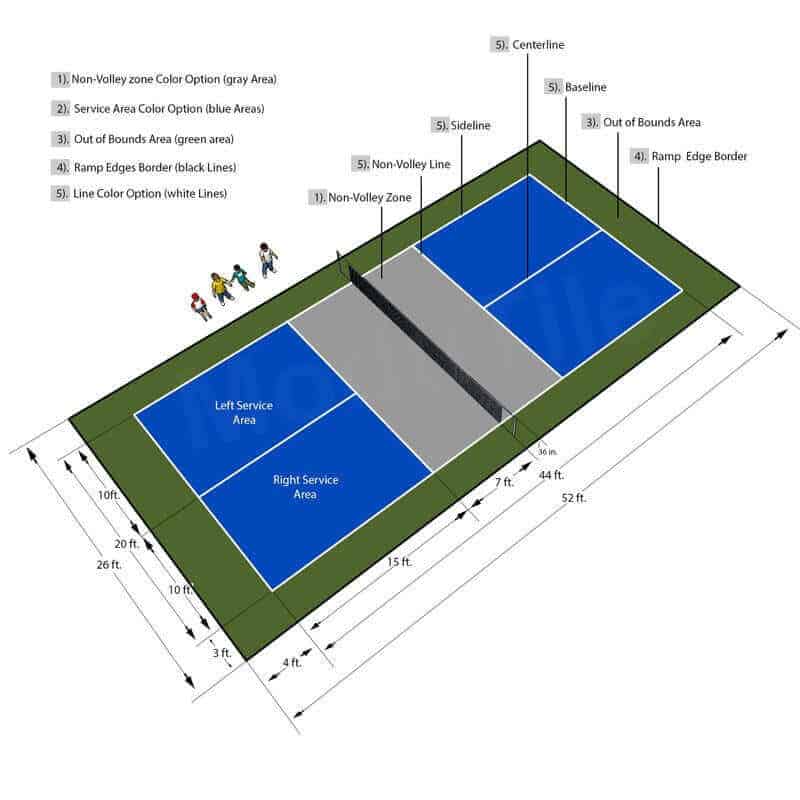Key Elements in the Building of Pickleball Courts: From Site Option to Final Coatings
The construction of pickleball courts includes a series of essential elements, beginning with the selection of an appropriate site that stabilizes availability with ecological considerations. Crucial aspects such as court dimensions, surface area materials, and water drainage systems considerably influence not only the high quality of play but likewise the long life of the facility. Moreover, attention to illumination and ending up touches can elevate the general experience for gamers and viewers alike. Understanding exactly how each of these parts interrelates might reveal insights that are commonly overlooked, triggering a better exam of best practices in court building.
Site Selection Requirements
When starting the construction of pickleball courts, it is important to pin down the site selection criteria that will certainly ensure ideal playability and access. The location should be quickly reachable for gamers, ideally positioned near suburbs or recreation center, to encourage engagement.
In addition, the surface needs to be level and stable, as uneven ground can result in safety hazards and influence gameplay. Appropriate drain is also crucial; selecting a website with great water runoff will certainly aid preserve court conditions throughout unfavorable weather.
An additional crucial consideration is the schedule of utilities. Access to electricity and water is needed for lighting and maintenance purposes. Furthermore, distance to vehicle parking facilities is crucial, assisting in easy accessibility for players and viewers alike.
Environmental aspects can not be neglected; all-natural shade from trees can boost player convenience, while exposure to prevailing winds might interrupt play. Lastly, zoning guidelines and community support need to be thought about to make certain that the project straightens with local standards and receives the backing it requires for successful application. By thoroughly examining these criteria, stakeholders can create an inviting and practical setting for pickleball enthusiasts.
Court Dimensions and Design
To make sure ideal gameplay and adherence to regulations, the dimensions and layout of pickleball courts need to be thoroughly specified. A common pickleball court measures 20 feet in width and 44 feet in size for both songs and doubles play.
The net elevation is evaluated 36 inches at the sidelines and 34 inches at the center, developing a mild dip that influences round trajectory. Court markings are similarly essential; lines should be 2 inches wide and distinctive in color to ensure presence.
Additionally, a barrier area bordering the court is advisable, normally expanding 5 to 10 feet past the sidelines and standards to suit players' motions and improve safety. Correct design and dimensions not only make certain conformity with official regulations but likewise enhance the total having fun experience, accommodating both recreational and affordable play. Cautious preparation in these locations is vital to the successful construction of pickleball courts.
Surface Area Material Options
Picking the ideal surface product for pickleball courts is important for guaranteeing optimum player efficiency and security. The choice of surface area can considerably affect gameplay, consisting of ball bounce, grip, and player comfort.
There are several choices available, each with its unique you can try this out characteristics. Asphalt is a preferred choice as a result of its sturdiness and reduced maintenance demands. It provides a strong playing surface area that can withstand different weather yet might call for regular resurfacing.
Concrete is an additional widely utilized product, providing exceptional longevity and a smooth surface. It permits for regular ball bounce however can be tough on gamers' joints, making it less desirable for lasting play without proper cushioning.
For those looking for enhanced comfort and shock absorption, cushioned acrylic surface areas offer a practical More Info option. These surface areas incorporate a base layer with an acrylic topcoat, supplying enhanced grip and a softer feeling, which is beneficial for minimizing the danger of injuries.
Last but not least, synthetic turf is acquiring traction, particularly for multi-purpose facilities. Its adaptability and reduced upkeep requires make it an eye-catching alternative, though it might not provide the same sphere feedback as typical hard courts. Careful consideration of these options will ensure an optimal playing environment.
Water Drainage and Lighting Factors To Consider
Proper water drainage and reliable illumination are vital components in the building and construction of pickleball courts, dramatically affecting both playability and safety. Ample water drainage systems stop water build-up, which can lead to slippery surfaces and damages to the court framework.
Lighting is similarly critical, especially for courts planned for evening usage. Appropriate lighting enhances visibility, making certain that players can see the sphere plainly and reducing the danger of mishaps. The placement of lighting components need to be strategically planned to get rid of shadows and provide even circulation of light across the court. LED lights are suggested for their power efficiency and durability, using intense lighting Discover More Here while decreasing operational expenses.

Last Coatings and Upkeep
After resolving water drainage and illumination considerations, attention transforms to the last surfaces and ongoing upkeep of pickleball courts. Typical choices include acrylic layers and specialized sporting activities surfaces that provide optimal grip and cushioning.

Seasonal upkeep might consist of resurfacing every few years, depending upon use and environmental aspects. Properly preserving webs, court lines, and surrounding areas is equally vital to offer a secure and enjoyable playing experience. By purchasing top quality finishes and adhering to an organized upkeep schedule, facility owners can guarantee their pickleball courts continue to be in excellent condition for many years ahead.
Conclusion
Finally, the successful building and construction of pickleball courts rests on meticulous attention to a number of crucial variables. Website selection should prioritize ease of access and terrain security, while court measurements and design must follow optimal standards for gameplay. The selection of surface area product dramatically affects gamer safety and security and efficiency. Efficient drain and appropriate illumination contribute to court durability and visibility. Finally, quality finishes and a durable upkeep routine are crucial for maintaining the court's problem, improving the general experience for players and viewers alike.